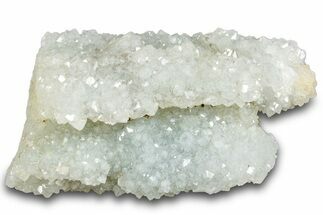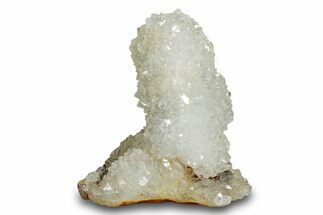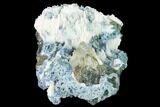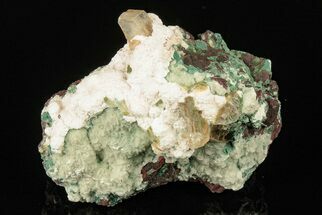This Specimen has been sold.
2.8" Blue and White Chalcedony "Strings" with Calcite - India
This is an unusual, 2.8" wide specimen of blue and white chalcedony "strings", collected from Maharashtra, India. The blue chalcedony strings formed over an unidentified green mineral that likely hung from the ceiling of the cavity that this specimen was collected from. There is a calcite crystal protruding through the blue chalcedony strings. These blue chalcedony specimens are often associated with mordenite
sprays.
It comes with an acrylic display stand.
sprays.
It comes with an acrylic display stand.
Chalcedony is any microcrystalline variety of silica composed of very fine intergrowths of quartz and mogánite: microcrystalline minerals have microscopic crystals that cannot be observed by the naked eye. Both quartz and mogánite have the same chemical formula SiO2 (silicon dioxide), but different crystal structures. When free from impurities, chalcedony is colorless and transparent. Depending on impurities present during formation, chalcedony can form in a wide variety of colors including red, yellow, green, blue, purple, grey, white, and numerous hues in between. Chalcedony is quite hard at 7 on the Mohs Hardness Scale: this matches its main component quartz, which is the benchmark mineral for the scale at 7.
Quartz is the name given to silicon dioxide (SiO2) and is the second most abundant mineral in the Earth's crust. Quartz crystals generally grow in silica-rich environments--usually igneous rocks or hydrothermal environments like geothermal waters--at temperatures between 100°C and 450°C, and usually under very high pressure. In either case, crystals will precipitate as temperatures cool, just as ice gradually forms when water freezes. Quartz veins are formed when open fissures are filled with hot water during the closing stages of mountain formation: these veins can be hundreds of millions of years old.
Calcite, CaCO3, is a carbonate mineral and the most stable polymorph of calcium carbonate. The other polymorphs are the minerals aragonite and vaterite. Calcite crystals are trigonal-rhombohedral, though actual calcite rhombohedra are rare as natural crystals. However, they show a remarkable variety of habits including acute to obtuse rhombohedra, tabular forms, and prisms. Calcite exhibits several twinning types adding to the variety of observed forms. It may occur as fibrous, granular, lamellar, or compact. Cleavage is usually in three directions parallel to the rhombohedron form.
SPECIES
Quartz var. Chalcedony & Calcite
LOCATION
Maharashtra, India
SIZE
2.8 x 2.4"
CATEGORY
ITEM
#168843
 Reviews
Reviews















